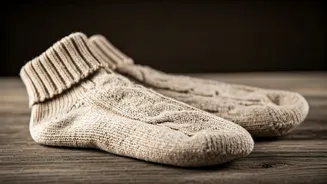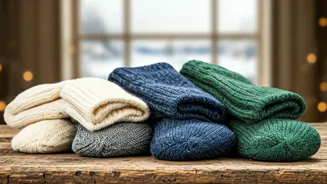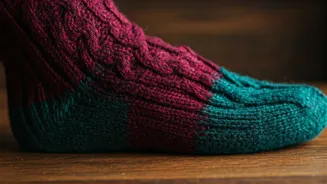Introduction: Winter Sock Essentials
Winter socks are crucial for maintaining comfort and warmth during the colder months. They serve as a vital barrier against the cold, helping to regulate
body temperature and prevent discomfort. The right pair of socks can make a significant difference, whether you're indoors or outdoors. Factors like material, thickness, and design all contribute to a sock's effectiveness. Choosing the right socks involves understanding these features and matching them to your specific needs and activities. This guide focuses on helping you select the perfect winter socks, ensuring your feet stay cozy and protected.
Material Matters: Choosing Wisely
The material of your winter socks largely determines their warmth and comfort. Wool, known for its excellent insulation, is a popular choice, providing effective warmth even when wet. Synthetic materials like polyester and acrylic offer moisture-wicking properties, keeping your feet dry. Blends, combining both natural and synthetic fibers, often provide a balance of warmth, durability, and moisture control. When selecting socks, consider factors like the intended activity, climate, and personal preferences to make an informed decision.
Wool vs Synthetics: Comparing Options
Wool socks are praised for their superior insulation and ability to keep feet warm, even when damp. However, they might require more careful washing and can be slightly itchy for some. Synthetic socks, on the other hand, excel in moisture-wicking and quick-drying capabilities, making them great for active use. They are generally more durable and easier to care for than wool socks. The choice between wool and synthetic socks hinges on individual preferences and the specific needs of the wearer, such as the activity level and sensitivity to materials.
Sock Features: Enhancing Performance
Beyond materials, certain features enhance winter sock performance. Cushioning in the footbed adds comfort and impact absorption, ideal for long walks or outdoor activities. Reinforced heels and toes increase durability, extending the lifespan of the socks. Compression socks offer benefits by improving circulation and reducing muscle fatigue, suitable for travel or extended standing. Understanding these features can help users select socks that provide added benefits and comfort.
Finding the Right Fit
The correct fit is key to the effectiveness of winter socks. Socks should fit snugly without restricting circulation. Check the size charts and consider the thickness of the socks when selecting your size. Proper fit ensures warmth, comfort, and prevents issues like bunching or blisters. Trying on socks with your usual winter shoes is advisable to guarantee the best fit and overall comfort.
Caring For Your Socks
Proper care ensures that your winter socks last longer. Always follow the washing instructions provided on the sock label. Generally, washing socks in cold or lukewarm water and avoiding harsh detergents helps to preserve the materials. Air drying or tumble drying on a low setting can prevent shrinkage and damage. Regular care keeps your socks in good condition, ensuring they provide warmth and comfort season after season.











